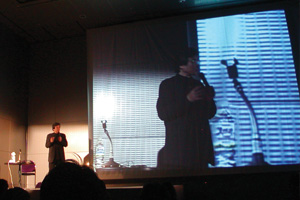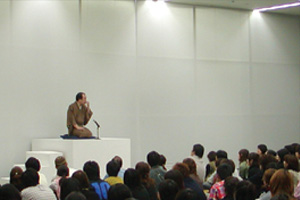Visual Humor Explained
Seigow Matsuoka spoke to a packed hall of international delegates on
the theme of 'humor- the heat and the beat'. The crowd got to hear
a detailed, interesting discussion and analysis of humor and what makes
things amusing. By asking why we laugh when other people stray away from
the conventional and ordinary, Seigow Matsuoka broke down the concept
of humor into three points: Costume/Disguise, taking on the appearance
of the object or person you are using to generate humor. Mimic/Imitation,
the intentional copying
of the action of a person or object, and Parody, the often extreme exaggeration
of these copied actions.
Using an wide range of references, from 'Monty Python's Flying Circus'
to well know Japanese 'Tora-san' movies, the audience was able to begin
to understand that humor is a universal language we all use and enjoy
no matter what cultural background we come from.
Traditional, ceremonial Japanese comic theater, which contains formalized
laughter, clearly illustrated how much detail (i.e. facial expressions)
matters in humor, independent of the humor's origins.
Audience members who enjoyed Seigow Matsuoka's talk were invited to continue
the discussion on humor in the following session 'The tradition of humor
and freshness considering traditional Japanese culture' with Koen Yanagiya
in the session. (BP)
|
 |
 |

